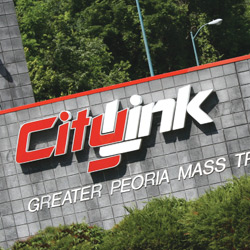
According to CityLink General Manager Tom Lucek, after receiving a report from the Illinois Public Transportation Association, “It looks like we are going to get the additional $3 million that we were promised, and our budget for next year can be based on a 10-percent increase, which will allow us to implement some of the…recommendations for new service. The economic recovery bill may give us an extra $4.2 million for capital; however, we have a need for $40 million, so we must continue to stay on top of the reauthorization bill later this year.
“I am working with the American Public Transportation Association’s (APTA) Small Operations Committee to include language in the new bill that would expedite the replacement of the oldest buses in the country first, so that we could eventually get a new fleet,” continued Lucek. Concerns of possible layoffs of employees and reduced bus services throughout Peoria were eased after CityLink officials received this report about the promised funding. This assures CityLink will receive area tax money that has already been collected but is still sitting in state coffers.
Residents voted to form the Greater Peoria Mass Transit District (GPMTD) in 1970. Board of Trustees representatives are appointed from the governing bodies of Peoria, Peoria Heights and West Peoria. At that time the federal government provided Peoria a grant to purchase 33 new buses. The last 12 new buses were added in 2005, seven of which are 40-foot low-floor buses, making it easier for passengers to enter and exit at curb level.
CityLink currently has an active fleet of 52 buses. The aging fleet is in dire need of replacement. A new bus costs a minimum of $345,000 and 12 months or more from grant request to delivery. A recent band-aid to help CityLink continue service was the purchase of 10 used buses from the Chicago Transit Authority. These buses, which would have been discarded, were purchased by CityLink for a total minimal amount of $10,000. Seven of the engines in these buses are still under warranty, and parts of the remaining buses will be used to repair the current fleet. In 2007, six used buses were purchased from Duluth, Minnesota, for the same purpose. This has also helped the fleet stay on the road.
CityLift, the paratransit vans, provides transportation for the physically and cognitively challenged as part of the Americans with Disabilities Act. According to Director of Maintenance John Anderson, “CityLink owns 28 paratransit vans. Only four of those vans are still in what the Federal Transportation Association calls their useful life span of five years. These four vans were purchased in 2004; therefore we need to replace our whole fleet of 28 vans as soon as we can.” New buses and vans are paramount in the future of service as the organization seeks funding from the stimulus package.
The APTA initiated a national campaign, Go Green, Go Public, which inspired CityLink employees to continue to work diligently to be part of the solution to our environmental problems. Public transportation saves fuel, reduces congestion and reduces the carbon footprint. CityLink provides access to jobs, thereby contributing to the economic vitality of the area; protects the environment by cutting down on pollution; and eases parking problems and traffic jams (one bus equals a line of moving cars stretching six city blocks). It also offers cost-effective transportation for those who need it and often have no other means of transportation.
When the price of gasoline began to rise in the spring of 2008, CityLink saw an immediate 30-percent increase in ridership. The number of rides provided monthly continues to be higher than in the previous year. CityLink currently provides over 2.5 million passengers with transportation on 22 routes in the communities of Peoria, West Peoria, Peoria Heights, East Peoria, Sunnyland, Creve Coeur, Pekin and Bartonville. By the end of the current fiscal year, it is predicted that CityLink will provide over three million rides. CityLink provides free service on all fixed routes to seniors 65 or older and disabled passengers who qualify for the state’s circuit breaker program.
In 2007, the Tri-County Regional Planning Commission conducted a regional study to see if there was a need for expanded public transportation in the Tri-County Area. It was determined that the cities of Washington and Morton want public transportation. Since that time, governing officials from both communities have inquired as to how to make service to their area possible.
Transit means business. The APTA reports that “public transportation provides economic opportunities. Every dollar communities invest in public transportation generates approximately $6 in economic returns. Every $10 million in capital investment in public transportation yields $30 million in increased business sales. Every $10 million in operating investment yields $32 million in increased business sales.” This happens in Peoria, too. In addition to providing rides to work, CityLink and CityLift have a presence which provides job opportunities for nearly 200 people. With a share of the stimulus package, CityLink will offer more positive economic impacts to the Peoria metro area.
The vision of management of CityLink and the GPMTD Board of Trustees is to purchase all needed new buses and paratransit vans. The long-range plan of the future includes the revision of routes to better serve passengers, building an updated garage facility for buses and mechanics, a second transit facility in Northwest Peoria, and expanding the parking lot for CityLink employees. iBi

